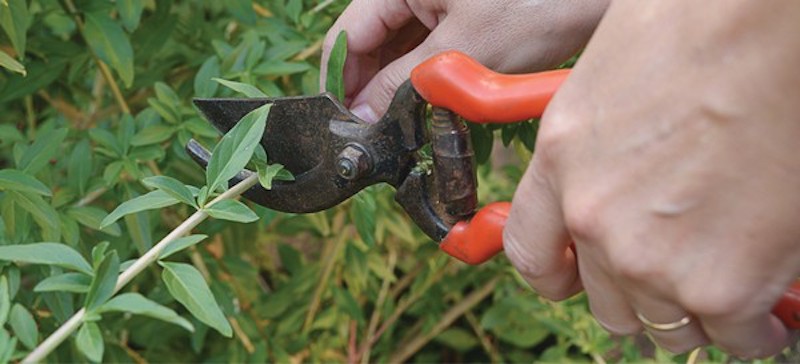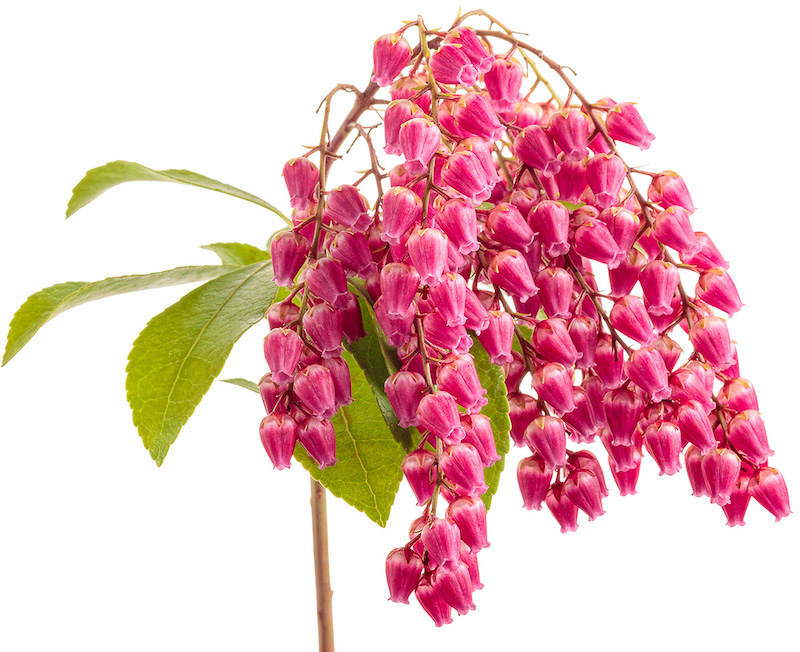Pieris japonica is a broadleaf evergreen shrub that has a dense upright growth habit. Severe pruning of Pieris will result in lots of colorful new foliage growth at the expense of flowering in the spring. Letting Pieris attain its natural shape with only light pruning will result in a less formal shrub with more blooming and denser foliage. Annual pruning in the early spring and deadheading of the spent flowers in early summer are the only pruning tasks needed. Pieris also tolerates hard pruning to revive an old shrub that has declined in vigor.

When to Prune Pieris
You can prune any winter-damaged branches early in the spring as the new growth is emerging. Dead, diseased, dying, or diagonal branches need to be removed all the way back to a main stem or branch. This will reduce opportunities for pests or diseases to attack and weaken the shrub. Cutting out diagonally growing branches also helps to improve air circulation and expose the shrub’s interior to sunlight. This pruning needs to be done carefully so as to not damage or remove the flower buds before they open.
Deadheading of spent flowers should be done at the end of blooming. All varieties finish blooming late in the spring or early summer. Removing the dead flowers will make room for the next season’s buds to form during the summer. Any hard pruning of the branches in the fall or winter will reduce flowering for a season.
Pieris responds well to rejuvenation pruning. Cutting the whole shrub back by ½ or more can restore Pieris’ natural shape if it has been badly pruned. New sprouts quickly grow from the old wood, no matter how far back a branch is cut. Pieris can also be cut back hard to improve the strength and vigor of its blooming.
Both types of rejuvenation pruning should be done early in the spring so that only one season of flowering will be lost. After a hard cutback, Pieris will quickly regrow foliage stems. These stems will need a light pruning the following spring to reduce any area of heavy foliage or crossing branches.

Why Prune Pieris
Many reasons support Pieris pruning, and all of them have to do with maintaining the overall health of the plant. Pruning improves air circulating through a dense growth of branches and foliage, making Pieris much less susceptible to mildews, rusts, and pests such as aphids. Deadheading spent flowers helps tidy up the plant for summer growth and contributes to good garden hygiene, which helps to prevent the spread of pests and disease to other plants.
Pruning away winter-damaged parts of Pieris will also help to keep the shrub healthy, so it is less likely to be attacked by diseases or pests. An old or overgrown Pieris can be rejuvenated and reshaped by cutting back the shrub by ½ or more of the overall size.

How to Prune Pieris
Step 1 - Deadheading
Carefully cut off spent flowers before they start to set seed. Cut the stem all the way back to a set of leaves or just above any flower buds. Try not to leave any naked stems sticking out. These will die back over the summer and give the shrub a rough look.
Step 2 - Winter cleanup pruning
Cut back any branches that are dead, diseased, dying, or diagonal to other branches. Make cuts all of the ways back to a healthy branch or main stem. These cuts will spur buds along the branches to develop into foliage and flower stems. Winter cleanup pruning also gets rid of damaged plant material that can be targeted by pests or diseases.
Step 3 - Rejuvenation pruning
Cutting out ½ or more of a shrub’s volume is considered a hard cutback or rejuvenating prune. Cut branches back to a main stem. Pieris responds well to severe pruning and will quickly regrow over the next season and even rebloom the following spring.
Pieris Pruning Tips
- Prune pieris lightly in winter to clean up damaged or dead branches
- Deadhead carefully to preserve next season's blooms
- Rejuvenation pruning should be done in early spring to allow for the most regrowth over the summer
- Make clean cuts all the way back to a main stem or branch for a tidy appearance
 |
Author Robbin Small - Published 8-11-2022 |
